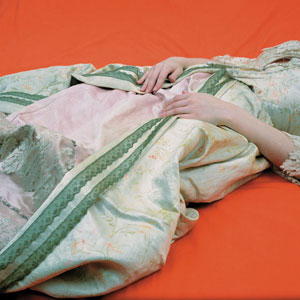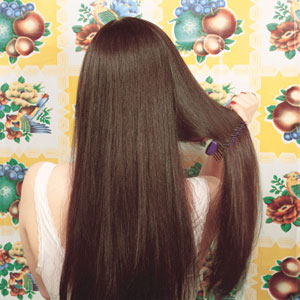
Quiet Curtsy
The Golden Slumbers of Deborah Paauwe
Think cupcakes and hair ribbons, lace and snowflakes. Think Maria von Trapp, the Jeans West girl and Elmer Batters. As a mix of imagery, these things might be thought of as softcore, they move us some way toward entering Deborah Paauwe’s world of happy-sad photographs of young girls. It’s a nice place to be.
Adelaide-based Paauwe was born in Pennsylvania in the United States in 1972 and moved to South Australia in 1985. Since graduating from the University of South Australia with a Bachelor of Arts degree (Visual Arts) in 1993 and then a Post-Graduate Diploma in Arts Management (1995) she has been producing what catalogue essays refer to as “Deborah Paauwe images”. Paauwe has a prêt-à-porter iconography, a basic, though perfected formula of intense primary colours, soft skin, plush fabric, close cropping, flooded light and a candy coating. A Paauwe picture oozes sweetness. But, deliberately, euphemistically crude (often corny) titles make all this saccharine loveliness shrivel up into something a bit sexy and quite often enigmatic. The artist pushes her carefully crafted aesthetic to the limit and makes it stick, and this is her real strength. Due in part to these distinctive features, Paauwe’s photographs have been included in the exhibition Photographica Australis at the Sala del Canal de Isabel II in Madrid as part of the ARCO 2002, she was the recipient of a Samstag Scholarship in 1999 and she appears in the books of Greenaway Art Gallery in Adelaide and Sutton Gallery in Melbourne.
Paauwe’s photographs were also included in the exhibition ‘the syntax of style’ at the Australian Centre for Photography in 2001, which featured artists “who exploit the language of fashion photography in the pursuit of art”. This was one of the first instances of Paauwe’s photographs curated under the direct rubric of fashion photography and its mediation through advertising. While studying in London during 2000 (courtesy of the Samstag) at the Chelsea College of Art & Design, Paauwe worked at the vintage clothing store Steinberg and Tolkien and borrowed the clothes featured in many of her photographs from the ‘Sugar Nights’ series (2000). The cropped and fragmented bodies from this and other series such as ‘Blue Room’ (1998) and ‘Tuesday’s Child’ (2001) are reminiscent of those images produced by a number of contemporary fashion photographers. Of interest on this point is German born Erwin Blumenfeld (1897-1969), one of the first fashion/art photographers to allow body parts to stand in for the whole, deploying the lessons of avant garde cinema. His famous eye and lip image for the cover of Vogue in January 1950, for example, confuses the commercial nature of fashion photography with the more experimental imperatives of art, rendering the genre as a stage for performative images. But while many in the industry have produced metonymical images, the narrative/fantasy elements of contemporary fashion photography that encompass a sex-death tension are regular commuters between the art and fashion worlds. For instance, the work of Japanese fashion photographer Izima Kaoru fully exploits a very particular art-fashion nexus. At Kaoru’s invitation, models and celebrities have been given the opportunity to imagine their own deaths – an outfit, a location and a scenario; drowned in Donna Karan, overdosed in Oroton or shot in Chanel. His photographs express something of the ‘beautiful victim’ mood that sometimes grips fashion photography (think Nick Knight, Juergen Teller) but which was flaunted by the Surrealists, who constantly depicted women as abstractions or represented them by a mess of metaphors for femininity.
Under surrealism, woman’s preferred form was a mannequin, itself a compromised object that found its most extreme form in Hans Bellmer’s erotic, often headless, dummy The Doll, of which he made many versions during 1930s. The sculpture’s white ankle socks and baby-doll shoes mixed with well developed thighs and overly pouty, often dual, vulvas made it a woman-child beast. Bellmer would slump it against a chair, under a bush or string up in a piñata-style contortion to be photographed. Many of Paauwe’s works also have this discordant and unharmonious quality, of ugliness and awkwardness as a sort of beauty – so polished and perfect at times so as to seem unreal. They are beautiful like champagne and chocolates are beautiful but with a wonderful perversity, derived from minor imperfections on the model’s skin. In short, the particular and the physical draw us in and then away from these idealised scenarios. Although they are staged in pretty dress-ups, the girls are often bound, bruised, grazed, scarred and scratched, with chipped nail polish on their dirty fingernails upon hands with Texta scribblings. The spontaneity of child photography is not at work here, and Paauwe toys with the notion that the camera has the power to enforces a voyeuristic separation of the photographer from the subject. She has molded these bodies into regulated shapes and poses, given them props, wound them in bric-a-brac and lifted their skirts. They have some of the cartoonesque, objectified, subjugated qualities of Bellmer’s dolls, the play objects that can be moved into position on the edge of a safety zone. The square format vignettes through which we view these mini dramas are also like views through the windows of a dollhouse. Paauwe’s Playing Around (1998/99), Quiet Curtsy (2001) and Only Words (2001) seem to say “play with me”.

Restless Sleeping Beauty
Paauwe guillotines the girls’ identity from the available body of evidence; they are removed from any sense of having a definite past or a possible future in the way Bill Henson’s teen models can be thought of addicts, prostitutes and runaways. However, they have a similar sexual agency. As Anne Marsh states, drawing on Freud, in her catalogue essay for the exhibition ‘Telling Tales: The Child in Contemporary Photography’, children “express themselves erotically and they aspire to grown up desires”. A Peeling (1998/99), Show of Hands (1998/99) and Lather (1998/99) for example, are seemingly innocuous but introduce a deliberate lack of innocence, prompting us to consider what has been carefully constructed. Equally, Silent Sleeping Beauty (2000) rests like a corpse, restrained and almost mummified by her Victorian dress. While in the narrative pair, Restless Sleeping Beauty (2000) pictures a girl waking from her solitary dreams, not to the kiss of Prince Charming but to her own self-made pleasures. Child sexuality in these images is just one more mask for us to consume – newness and youth, innocence and nubility function as inviolable attractions to acts of violation.
Paauwe wants us to look and she seeks to make the experience as pleasurable for us as possible. The repertoire of poses used are a mix of coyness and availability, awkwardness and knowingness, exposure and concealment. Like most pedophiliac representations – where the subject is represented through the desires of the camera-wielding adult – the child is made to adopt a deliberately inflexible, artificially aesthetic posture. Whether or not this is the intention, Paauwe’s images escape being creepy. It would seem, of course, that as a woman photographer (like Julia Margaret Cameron or Sally Mann), Paauwe’s photographs of young women and girls are naturally understood as being derived from an artistic interest that involves a parity of power structures and secret girls’ business. The placement of herself in the photographs too, means that whatever is tellable about the treatment or presentation of these models must also be true for Paauwe. So while these photographed bodies take on, in a formal sense, the eternal quality of ancient Greek sculpture and are rigid, headless, handless, fragmentary beauties, they are also child goddesses. Simultaneously, they are untouchable, young, pristine and ‘brand new’ as well as available, inviting and accessible. Paauwe’s position as a woman assists her in promoting the knowledge that if the Lolita-esque lollipop in Red and Write (2000) and Red and Ripe (2000) was to be actually licked, this naïve and virgin paradise could be in trouble. Precariously positioned between child and adulthood, the painful transition through puberty is publicly explored as ‘come on’ gestures are made clumsily and deliberately. Paauwe continually questions whether or not we can appreciate innocence now without bringing cynicism to bare on our ideas about what childhood represents. In light of such cases as the JonBenet Ramsey and James Bulger murders – where children are not just the victims but also the perpetrators of malicious crimes – this may be even harder. The notorious evil-child roles in films such as The Exorcist (1973) and The Omen (1976) remind us that popular culture has long envisioned children as the faces of innocence behind absolute terror.

Brush Stroke 1998
Paauwe’s own frequent, but uncertifiable, appearance in the photographs creates a different kind of threshold that rests between voyeurism and narcissism, biography and fantasy. Paauwe explores her Chinese-Dutch heritage, performing the role of an exotic temptress in works such as Bed Time Story (1998) and Brush Stroke (1998). In the former, her long, black hair is tucked behind her exposed shoulders, the wallpaper indicates a boudoir and she is moved by an unknown force to clench her pillow. In Brush Stroke the same beautiful hair is brushed our way, but this time with the fruit and flowers wallpaper of a domestic kitchen setting. Both photographs, like much of Paauwe’s work, construct a version of femininity that flirts with the ancient stereotypes of women as either Madonnas or whores. However, the kind of John Berger reductionist view that, ‘men act and women appear’ seems too simple with which to tackle the work of Paauwe. These works operate within our more permissive (post)feminist moment where the kind of spectatorial pleasures disavowed by critics such as Laura Mulvey are being reaffirmed. Paauwe’s photographs of disconnected, cropped bodies are not a contemporary critique of representations of the female form, artistic or otherwise. One almost suspects that collectors of Paauwe’s works are likely to be female, like her commentators.
The scenes Paauwe creates don’t make absolute sense. But play is a field of freedom for art, where the rules of natural cause and effect can be suspended. She works in what has long been termed the directorial mode. Her use of the human presence is predetermined, highly controlled and molded inside the comfort zone of the studio. Paauwe is fastidious with regard to the works’ execution but not so serious that the elements of kitsch, fun and even foolishness aren’t also pushed, along with a sense of sensuality and mystery. She revives Victorian social and aesthetic codes only to imbue a scene with something jarringly contemporary. A girl curtsies while K-mart knickers peak through her antique silk slip. Paauwe is the creator of worlds without danger but also without language or politics, they are strange Utopias that in many cases lead to a frustrated narrative. There is a perfect sterility to the role-playing in these photographs where the will of the subject has been surrendered to the dictates of the photographer, who directs her cast of characters in the drama portrayed. She in turn challenges the seeming transparency of her photographs and puts image making in question. And while Paauwe’s photographs may of course be informed by none or all of the above references, it seems that the works themselves are, fortunately, not so completely resolved either.
© Kate Rhodes 2002
Kate Rhodes is Curator at Craft Victoria. She was formerly a curator of photography and contemporary art at the National Gallery of Victoria from 2001-06.